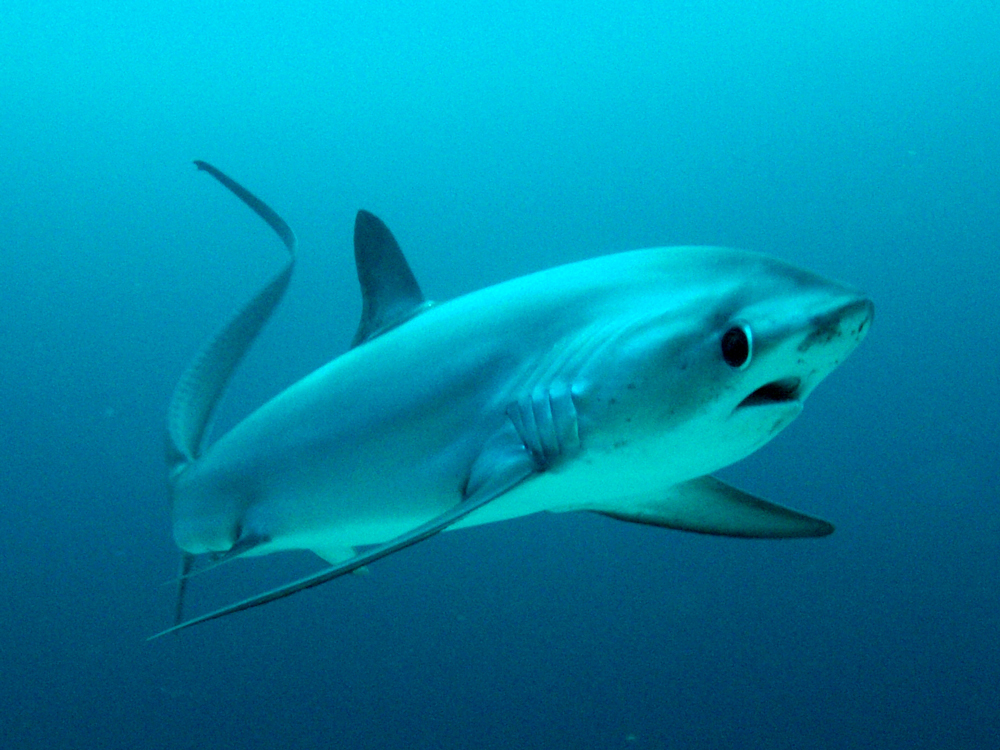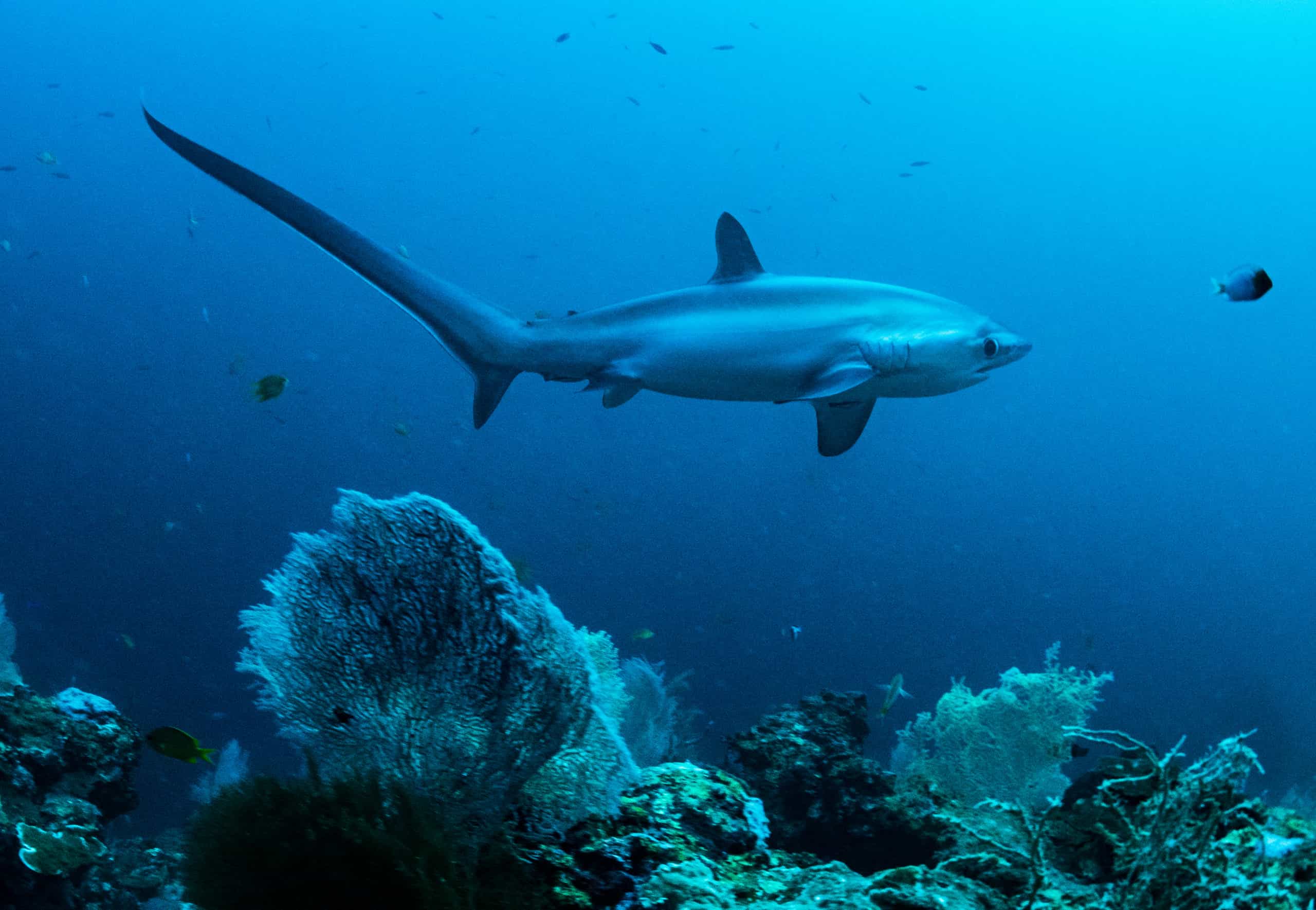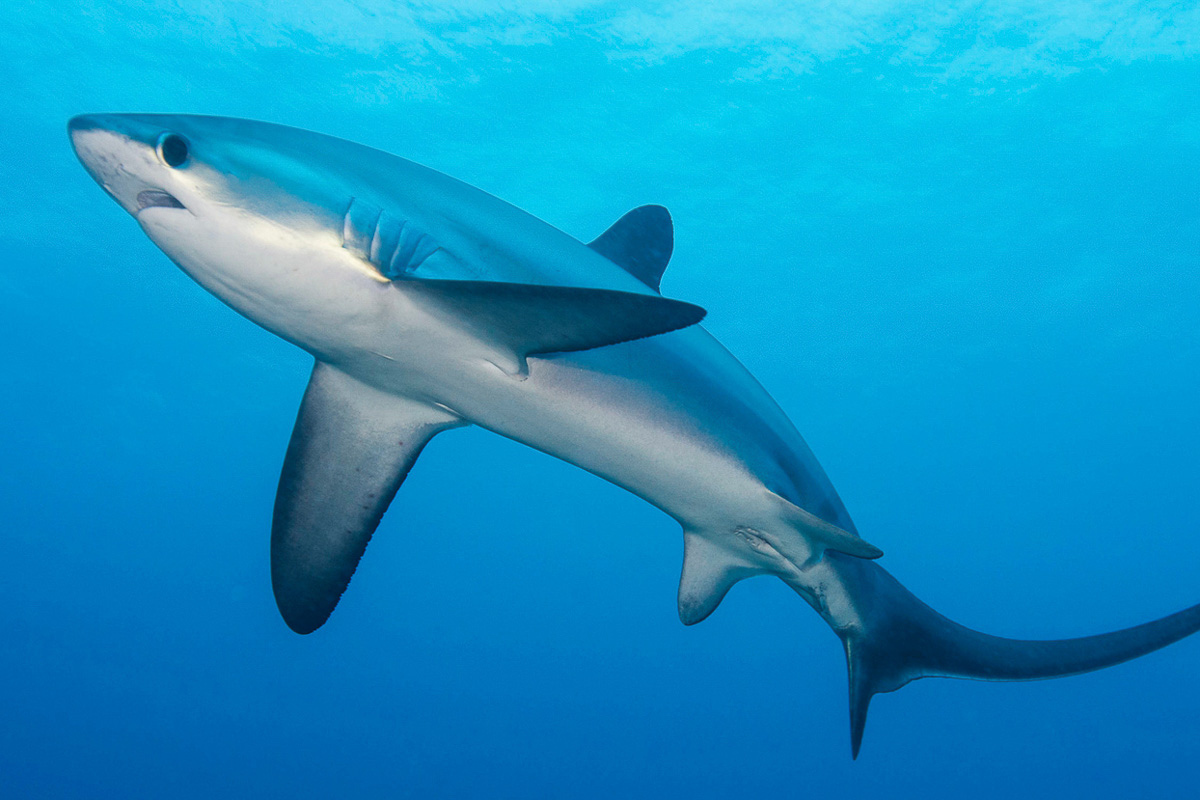The Enigmatic Thresher Shark: Ocean's Long-Tailed Hunter
Deep within the vast, mysterious blue, there swims a creature of remarkable grace and predatory prowess: the thresher shark. Instantly recognizable by its extraordinarily long, whip-like tail, this magnificent marine animal is a true marvel of evolution. Far from the fearsome image often associated with sharks, thresher sharks are fascinating hunters, using their unique anatomy in an astonishing display of skill to secure their meals. Understanding these elusive giants not only sheds light on the intricate balance of marine ecosystems but also highlights the critical need for their protection.
This article delves into the captivating world of the thresher shark, exploring its unique characteristics, its life in the ocean, and the challenges it faces. From its scientific classification and global distribution to its ingenious hunting techniques and conservation status, we invite you to discover the secrets of this incredible long-tailed predator.
Table of Contents
- Unveiling the Thresher Shark: A Taxonomic Journey
- Anatomy of a Hunter: The Thresher Shark's Unique Features
- Global Wanderer: Distribution and Habitat
- Life in the Deep: Behavior and Ecology
- Reproduction and Life Cycle
- Facing the Storm: Threats to Thresher Sharks
- Guardians of the Ocean: Conservation Efforts for Thresher Sharks
- Thresher Shark FAQs
Unveiling the Thresher Shark: A Taxonomic Journey
The thresher shark belongs to the family Alopiidae, a distinct group within the larger order of mackerel sharks. These are not just any sharks; they are specialized predators, instantly identifiable by a single, remarkable feature: their incredibly elongated upper caudal fin lobe, which can be as long as the rest of their body. The family name, Alopiidae, is derived from the Greek word "alopex," meaning "fox," a creature renowned for its resplendent tail – a fitting comparison for these marine acrobats.
There are three living species of thresher shark, each with its own unique characteristics and preferred habitats, yet all united by their signature tail and predatory lifestyle. These three species are:
- Common Thresher Shark (Alopias vulpinus): Also known as the Atlantic Thresher, this species is often cited as the largest of the three, capable of reaching impressive lengths.
- Bigeye Thresher Shark (Alopias superciliosus): Characterized by its unusually large eyes, adapted for hunting in deeper, dimmer waters. While the common thresher is often considered the largest species by length, Bigeye threshers are normally the largest in terms of overall bulk or average size among the three.
- Pelagic Thresher Shark (Alopias pelagicus): Generally the smallest of the three species, this thresher shark prefers the open ocean, or pelagic, environment.
All three species are large carnivores, playing vital roles as apex predators in their respective ecosystems. Their classification highlights their unique evolutionary path, setting them apart from other shark families and underscoring their specialized adaptations for survival in the vast ocean.
Anatomy of a Hunter: The Thresher Shark's Unique Features
The thresher shark is a marvel of biological engineering, perfectly adapted for its life as an oceanic predator. Its streamlined body, powerful musculature, and distinctive coloration all contribute to its success, but it is undoubtedly its tail that captures the most attention and defines its hunting strategy.
The Iconic Tail: Nature's Whip
The most striking anatomical feature of the thresher shark is the extraordinarily long upper lobe of its caudal fin, or tail. This elongated structure can account for nearly half of the shark's total body length, making it one of the most disproportionate tails in the animal kingdom. This isn't merely for show; it's a highly specialized tool, used with incredible precision to stun prey. When a thresher shark encounters a school of fish, it will swim into the group, then use its powerful tail to deliver a swift, forceful blow, incapacitating or killing several fish at once, making them easy targets.
In terms of size, thresher sharks are truly large. The largest known thresher sharks can reach a length of more than 6 meters (20 feet). The common thresher, specifically, is known to reach lengths of around 6 meters (20 feet) and can weigh up to 600 kilograms. The maximum recorded weight for any thresher shark is around 750 pounds, showcasing their substantial size. While the common thresher is often cited as the largest species by length, Bigeye threshers are normally considered the largest overall, with Pelagic threshers being the smallest of the three species.
Beyond their tail, thresher sharks possess other remarkable adaptations for survival in the open ocean. They exhibit countershading, a common camouflage technique where their dorsal (top) side is dark and their ventral (bottom) side is light. This helps them blend in with the dark depths when viewed from above and the bright surface when viewed from below, making them harder for both prey and predators to spot. Furthermore, thresher sharks are one of the few shark species capable of endothermy, meaning they can maintain a body temperature warmer than the surrounding water. This adaptation allows them to hunt efficiently in colder waters and sustain high levels of activity, giving them an edge in pursuing fast-moving prey.
Global Wanderer: Distribution and Habitat
Thresher sharks are true cosmopolitans of the ocean, found in tropical and temperate seas throughout the world. Their widespread distribution underscores their adaptability to various marine environments, from the sun-drenched surface waters to the cooler, deeper realms of the continental shelves.
The common thresher shark (Alopias vulpinus), for instance, is a particularly widespread species. It inhabits tropical and temperate waters in almost every major ocean basin. Along the coast of North America, they can be found from Oregon down to Mexico in the Pacific Ocean, and from Maine down to Florida in the Atlantic Ocean. This migratory species even passes through UK waters during the summer months, following their prey and preferred water temperatures. While they are known to be present off the coast of Rhode Island, they are rarely seen near the shoreline, indicating their preference for deeper, offshore waters.
While thresher sharks are primarily pelagic, meaning they inhabit the open ocean far from the coast, their life cycle brings them closer to land at crucial times. They breed in coastal waters, utilizing these shallower, more protected areas as nurseries for their young. Juvenile thresher sharks will stick to these safer, shallower waters until they reach maturity. Once they are old enough and large enough to fend for themselves, these young sharks will migrate to the deeper, open ocean, joining the adult population in their vast oceanic hunting grounds. This dual habitat use highlights the importance of both coastal and open-ocean conservation efforts for the survival of the thresher shark.
Life in the Deep: Behavior and Ecology
The life of a thresher shark is a testament to efficiency and adaptation. These sharks exhibit a range of behaviors that are critical to their survival, from their unique hunting methods to their impressive longevity and migratory patterns.
Predatory Prowess: Tail-Slapping Strategy
At the heart of the thresher shark's ecological role is its predatory prowess. They feed primarily on squid and schooling fish, such as mackerel, herring, and anchovies. What sets them apart is their extraordinary hunting technique, which relies entirely on their elongated tail. When a thresher shark encounters a dense school of prey, it doesn't simply charge in. Instead, it employs a sophisticated strategy: it will swim into or around the school, then, with incredible speed and precision, deliver a powerful whip-like blow with its tail. This stunning action disorients, injures, or even kills multiple fish at once, making them easy pickings for the shark to then consume. This "tail-slapping" technique is a highly specialized adaptation that maximizes hunting efficiency and minimizes energy expenditure, truly showcasing the thresher shark as a master of its domain.
Beyond their hunting, thresher sharks are known for another spectacular behavior: breaching. If you’re lucky, you might see this magnificent shark jump high out of the water into the air, a truly breathtaking sight. While the exact reasons for breaching are not fully understood, it's thought to be related to hunting, communication, or even parasite removal.
Thresher sharks grow slowly, a characteristic common among many long-lived shark species. They reach lengths up to 18 feet, though as mentioned, some can exceed 20 feet. This slow growth rate is coupled with a remarkably long lifespan, with individuals living anywhere between 19 and 50 years. They mature relatively late in life, typically when they reach about 5 years old and approximately 5 feet in length. This slow maturation and long lifespan make them particularly vulnerable to overfishing, as populations take a long time to recover once depleted.
Reproduction and Life Cycle
The reproductive strategy of the thresher shark is intrinsically linked to its migratory patterns and habitat use. While adult thresher sharks spend much of their lives in the vastness of the open ocean, they return to specific coastal waters to breed. These inshore areas serve as crucial nurseries, providing a safer environment for their young during their most vulnerable stages.
Thresher sharks are ovoviviparous, meaning the eggs hatch inside the mother's body, and the young are born live. Litters are typically small, often consisting of only two to six pups. This low reproductive rate, combined with their slow growth and late maturity, further contributes to their vulnerability. The gestation period is thought to be quite long, though precise details can vary between species. Upon birth, juvenile thresher sharks will stick to these shallower, safer coastal waters. These areas offer protection from larger predators and provide abundant food sources suitable for their smaller size. They will remain in these nursery grounds until they reach a certain size and maturity, typically around 5 years old and 5 feet in length. After this period, they embark on their journey to the deeper open ocean, joining the adult population and beginning their own extensive migrations across the world's seas. This cycle underscores the critical importance of protecting both their open-ocean habitats and their vital coastal breeding grounds.
Facing the Storm: Threats to Thresher Sharks
Despite their impressive adaptations and formidable presence in the ocean, thresher sharks face a growing number of threats that jeopardize their long-term survival. As with many large, migratory marine species, human activities pose the most significant dangers.
One of the primary threats to thresher sharks is overfishing. Their meat is consumed, their fins are highly valued in the shark fin trade, and their hides are used for leather. Due to their slow growth rate, late maturity, and low reproductive output, thresher shark populations are particularly susceptible to fishing pressure. When too many individuals are removed from the population before they have a chance to reproduce sufficiently, the species struggles to recover, leading to rapid declines. They are often caught as bycatch in various fisheries targeting other species, further exacerbating the problem.
Habitat degradation also plays a role, particularly impacting their crucial coastal breeding grounds. Pollution, coastal development, and human disturbance in these sensitive nursery areas can disrupt their reproductive cycles and reduce the survival rates of juvenile thresher sharks. Climate change, leading to ocean warming and acidification, can also indirectly affect thresher sharks by altering their prey distribution and overall ecosystem health. The combination of these factors places immense pressure on thresher shark populations globally, pushing some species towards endangered status.
Guardians of the Ocean: Conservation Efforts for Thresher Sharks
Recognizing the significant threats they face, conservation efforts for thresher sharks have become increasingly vital. Protecting these magnificent creatures is not just about preserving a single species; it's about maintaining the health and balance of the entire marine ecosystem where the thresher shark plays a crucial role as an apex predator.
International and national regulations are being implemented to manage thresher shark fisheries, including catch limits, gear restrictions, and bans on finning. Organizations worldwide are working to raise awareness about the plight of these sharks and advocate for stronger protections. Scientific research is also crucial, helping us to better understand their migration patterns, population dynamics, and habitat needs, which in turn informs more effective conservation strategies.
For individuals, supporting sustainable seafood choices that avoid thresher shark products, advocating for marine protected areas, and reducing our overall environmental footprint can make a difference. Learning more about thresher sharks and how you can protect them is the first step towards ensuring that future generations will also have the opportunity to marvel at this incredible long-tailed hunter. Every effort, no matter how small, contributes to the larger goal of safeguarding the thresher shark and the health of our oceans.
Thresher Shark FAQs
Here are some frequently asked questions about the fascinating thresher shark:
- How do thresher sharks use their tail? Thresher sharks use their incredibly long tail to stun their prey, typically schooling fish and squid. They whip their tail through schools of fish, incapacitating them before consuming them.
- How big do thresher sharks get? The largest known thresher sharks can reach over 6 meters (20 feet) in length. The common thresher is often cited as the largest species by length, while Bigeye threshers are normally the largest in terms of average size or bulk.
- Where are thresher sharks found? Thresher sharks are found in tropical and temperate seas worldwide. They are migratory, inhabiting both open ocean (pelagic) environments and coastal waters for breeding.
- Are thresher sharks dangerous to humans? Thresher sharks are generally not considered a threat to humans. They are shy and prefer to avoid human interaction, focusing on their natural prey. There are very few documented cases of thresher shark attacks on humans.
- What do thresher sharks eat? Their diet primarily consists of schooling fish like mackerel, herring, and anchovies, as well as squid.
- What is the conservation status of thresher sharks? All three species of thresher sharks are listed as vulnerable or endangered by the IUCN Red List, primarily due to overfishing and bycatch.
Conclusion
The thresher shark, with its iconic long tail and remarkable hunting strategy, stands as a testament to the incredible diversity and adaptability of marine life. From its unique anatomy and global migrations to its vital role as an apex predator, the thresher shark is a creature of profound ecological importance. However, like many of our ocean's magnificent inhabitants, it faces considerable challenges, primarily from human activities.
Understanding the life and struggles of the thresher shark is a crucial step towards its preservation. By supporting sustainable practices, advocating for stronger marine protections, and continuing to learn about these amazing animals, we can all contribute to ensuring that the thresher shark continues to grace our oceans for generations to come. Let's work together to protect these long-tailed hunters and the intricate ecosystems they call home. Share this article to spread awareness, and consider exploring more about ocean conservation efforts that make a real difference.

Floating Thresher shark photo and wallpaper. Cute Floating Thresher

Thresher Shark Fish Facts - A-Z Animals

Thresher Shark Jumping Out Water